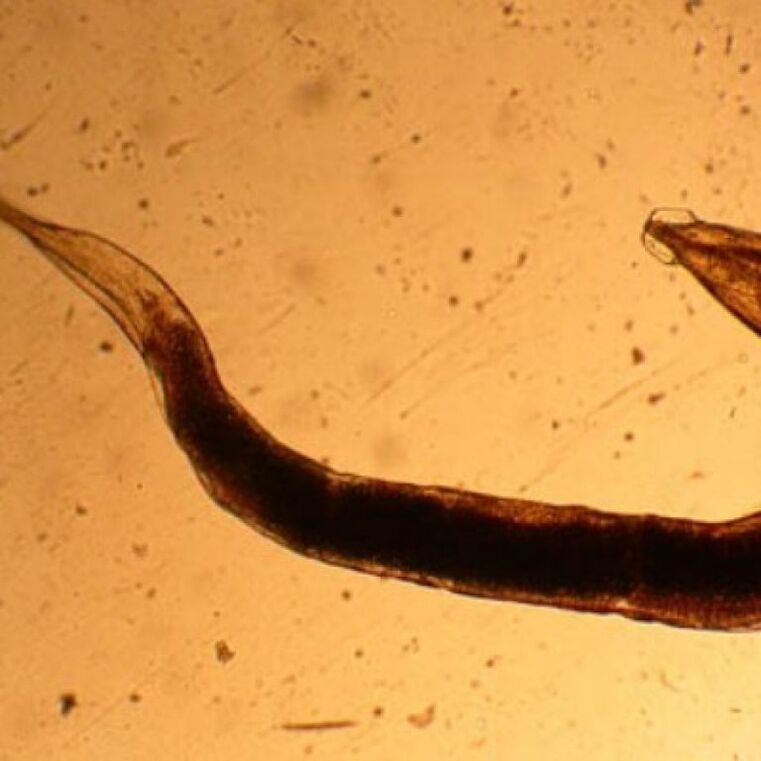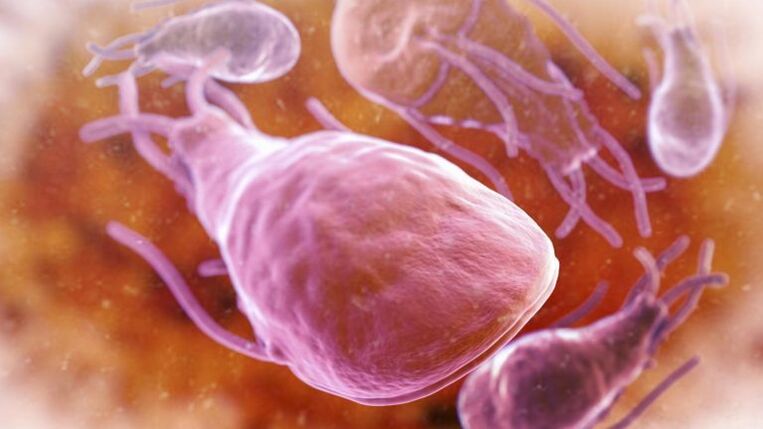For parasitologists, parasites in the human body are a common part of work. For normal patients, helminthic invasion is a terrible pathology. The situation is exacerbated by the fact that one tends to increase the scale of the problem without knowing the enemy with a view. A basic knowledge of the types of parasites that can live in the human body will help overcome fear. And by knowing the problem, you can already build a method to overcome it or the principle of protection against it efficiently. In the material below, we will analyze which worms are parasites in the human body.
Types of worms in the human body
Keep in mind that not all real life worms in the human body can survive. For many people, natural habitats are animal organisms, water, or just soil. The following is a list of the most common parasites in the human body with concomitant clinical manifestations.

Pinworm
This is the most common parasite entering the human body. Moreover, humanoid primates can suffer from enterobiasis. Often, cream worms are localized in the body of preschool children. Children 1 to 10 years old are sick.
Cream worm infection occurs when a healthy person comes in contact with an infected person (shaking hands, touching dirty linen, towels, etc. ) in an unwashed hand condition. Next, with food, pinworm eggs enter the human body.
Important: insects (flies, cockroaches) can also carry worm eggs.
An adult woman crawls out of the anus at night and lays eggs in the folds of the anal skin, causing severe itching. Also, patients may experience periodic pain in the lower abdomen if the intensity of helminthic invasion is already high. These are the symptoms of a parasitic infection that shows the cream worms in the body. They can be mixed with general fatigue and allergic skin reactions.

Giardia
Protozoa genus flagellate. The localization of such parasites in the human body is more common in the small intestine. However, with blood flow, protozoa can reach the liver and gallbladder. Parasites enter a person through dirty hands, unwashed vegetables / fruits, or by drinking dirty water.
Symptoms of lamblia parasites are:
- Pain in right hypochondrium;
- Disorders of feces;
- Excessive gas intake;
- Nausea;
- Neurosis;
- Manifestations of skin allergies.
Ascaris
Ringworm in humans most often live in the small intestine. But at the same time, with blood flow, they can easily migrate to any organ. Often localized in the heart, lungs, liver and even in the brain.
Infection with helminthic attacks occurs through dirty hands, where parasitic eggs from vegetables, fruits, soil, etc. can remain. In this case, the symptoms of the parasite vary depending on the phase of the disease. Therefore, during larval migration, the following parasitic symptoms in the body are observed:
- Increased body temperature (38 degrees);
- Dry cough at night with shortness of breath;
- Swollen lymph nodes.
With the location of worms further in the human body, the following symptoms are formed:
- Stool disorders (constipation and diarrhea);
- Nervous disorders;
- Pneumonia;
- Heart failure;
- Nausea;
- Vomiting;
- Frequent headaches;
- Stomach ache.

Amoeba Histologi
Amoeba is a protozoa parasite. It affects the human body through dirty hands, through the consumption of dirty foods (vegetables, fruits, herbs) and also through anal contact. Flies can also carry amoebiosis. Amoeba provokes the formation of boils in the large intestinal wall and further damage to other organs and systems. In this case, the signs of parasites in the body are as follows:
- Feces with blood and mucus;
- Pain in the abdomen;
- Anemia;
- Weakness and general fatigue;
- The formation of abscesses in organs where parasites can be localized.
Toksokara
A round helminth that provokes a helminthic invasion called toxocariasis. In this case, the parasite can be localized in the intestine, in the eyes, in the brain. Toxic carriers are fangs (dogs, wolves, foxes, etc. ). Infection occurs either through contact with a sick animal, or through indirect contact with its feces. Infection with this type of parasite carries a variety of symptoms, depending on the organ in which the worm larvae have settled. So, with intestinal toxocariasis, the symptoms will be as follows:
- Nausea and vomiting;
- Diarrhea and constipation;
- Pain in the abdomen.
With ocular toxocariasis, patients have the following signs of parasitic infection:
- Decreased vision;
- A purulent discharge from the affected eye;
- The formation of boils on the eyelids;
- Redness of the eyelids;
- Retinal detachment.
If toxocara resides in the brain, then the patient has the following signs of parasites in the body:
- Headache;
- Dizziness and fainting;
- Increased intracranial pressure;
- Neatness and hallucinations;
- Decreased vision and concentration.
In these cases, the clinical picture is often confused with brain oncology.
- With cardiac toxocariasis, patients will experience heart failure, such as tachycardia, arrhythmia, valve failure, and heart disease.
- If the respiratory system is affected by toxins, there will be signs of pneumonia or bronchitis, as well as frequent shortness of breath.
- If the worm settles under the skin, then the patient will feel itching, movement, and redness will be observed on the skin at the helminth location.

Wide Band
This worm lives in the small intestine of its host. It gets there by mouth along with contaminated food (fish, roe fish) or with water. The signs of worms in the body like this are as follows:
- Pain in the abdomen;
- Nausea;
- Persistent anemia that cannot be fixed with iron supplements;
- At the advanced pathological stage, the patient experiences intestinal obstruction due to the large accumulation of parasites in it.
Pig tapeworm
This helminth lives in the bodies of livestock (rabbits, pigs), as well as in the bodies of dogs and camels. It enters the human body along with contaminated flesh that has undergone inadequate heat treatment. If an adult worm is found in the patient's body, the diagnosis is "teniasis". If the helminth is detected at the larval stage, then the diagnosis is "cysticercosis".
Important: patients with teniasis are dangerous to themselves (ingestion of parasitic larvae in the brain, eyes, skeleton) and to others.
The list of parasitic symptoms in the human body looks like this:
- Significant decrease in appetite;
- Severe headache;
- Pain in the abdomen;
- Fainting;
- Decreased vision (with eye teniasis).
Important: treatment for swine tapeworm is only carried out in the hospital under specialist supervision.
.jpg)
Bovine tapeworm (tapeworm)
Parasites that live in the human body in one individual. He got there with infected beef. The list of parasitic signs in the human body looks like this:
- Uncontrollable appetite and weight loss;
- Seats are unstable;
- Pain in the abdomen;
- Manifestations of severe allergies;
- Nausea.
Important: parasites come out on their own when using certain anthelmintic drugs. Moreover, the maximum length is about 12 meters.
Necators and mine worms
These round parasites enter the human body regularly through dirty hands and food, or through soil through contact with them. The symptoms of the presence of parasites in the human body look like this:
- Rash on the body in the form of papules and vesicles (acne with purulent content);
- Severe tuberculosis with shortness of breath;
- Abdominal pain;
- Persistent anemia;
- Diarrhea;
- Nausea;
- Critical loss of appetite.

Alveococcus
This parasite belongs to the cestode group. At the same time, it should be noted that helminth is very dangerous for humans because it first becomes the focus of major inflammation in the liver, and then its metastases spread to other organs. Human infection occurs through the absorption of oncospher helminth into the human mouth. Often this happens when cutting animal carcasses, while hunting, when using ingredients and berries collected in the forest and processed inadequately for food, as well as through direct contact with invasive infected animals. In this case, only a specialist can assess the symptoms and tactics of treatment. The clinical picture of helminthic invasion looks like this:
- Nausea and specific belching;
- Pain in right hypochondrium;
- Allergies;
- Itching on severe skin;
- Swelling of the place where the parasite is localized and the abscess explodes.
Important: Localization of such aggression is often found in the lungs or brain. They just get rid of parasites immediately.
Echinococcus
Canids and cats are carriers of echinococcus. In this case, the person suffering from the parasite is only an intermediate host. The danger of echinococcus in humans lies in the fact that helminths seriously affect a person's organs and systems, provoking the formation of cysts in them. Often people who work with animals and meatballs are infected with echinococcus. That is, parasites can enter the human body when cutting animal carcasses, when eating contaminated meat or water. It should be noted here that signs of the presence of parasites in adults may not appear for long. When the symptom phase is over, the following clinical picture appears:
- Severe itching;
- Itchy skin;
- Pain at the location of parasitic larvae;
- Fever and fever (subject to cysts).
Gnatostoma
This type of helminth enters the human body with contaminated poultry, fish or frog meat. You can also be infected with dirty water with worm larvae in it. The presence of the worm in the human body is indicated by the following symptoms:
- Severe tuberculosis;
- Pain in the area where parasitic larvae are located;
- Severe swelling;
- Itching on severe skin;
- Increased body temperature.
Important: after a week, all symptoms disappear on their own, but reappear with normal frequency over the years. The main danger is damage to the eyes and brain with worms. This can be fatal.

Schistosoma
Worm flux. It is dangerous because it can penetrate the human body even through intact skin. Infection occurs in dirty waters (more often in Africa), when washing clothes with dirty water or when watering the soil with it. In the acute stage of aggression, the following first signs appear:
- Very high body temperature (up to 39 degrees and above);
- Formation of papules on the body;
- Itching on severe skin.
In the chronic stage, the disease manifests itself in the form of symptoms of prostatitis, colitis, colpitis, ascites, renal hydronephrosis, etc. Schistosomiasis can be detected by analyzing urine.
Trichinella
A round parasite that parasites the muscles of the human body at the larval stage and migrates to the small intestine after maturity. Trichinella can kill humans. You can be infected with such aggression when eating wild and domestic meat that is less fried / cooked with worms. If the reader does not know how to determine the presence of such parasites in the body, then the clinical picture of the pathology looks like this:
- Severe vomiting and diarrhea;
- Pain in the abdomen;
- Loss of appetite;
- Muscle pain;
- Skin rash;
- Eyelid moisture;
- Temperature rises to 40 degrees.
Important: Trichinosis is the only helminthic invasion in the human body that is also treated with corticosteroid drugs.
By knowing the parasites that can live in the human body, and how infections occur, as well as any symptoms of helminthic infections, you can keep yourself and your loved ones from being infected. And if you suspect an infection with one or another type of parasite, get specific help in time.
























